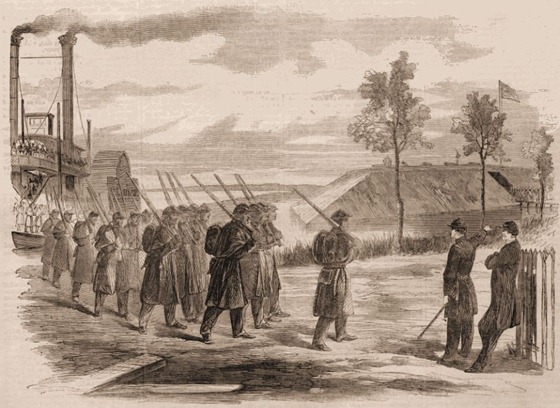WE publish on page 133 two illustrations of THE FIRST LOUISIANA NATIVE GUARDS, from sketches by our special artist, Mr. Hamilton.
It is now some five months since General Butler’s attention was called, by certain free colored men in New Orleans, to the fact that they held commissions from Governor Moore, of Louisiana, as duly enrolled officers of the Confederate army, and requesting to transfer their services to the United States. General Butler, with that keen perception for which he is so remarkable, at once saw the bearings of this important matter, granted the request of his applicants, and issued his order mustering the regiment into our service, under the command of Colonel (then Lieutenant-Colonel) Spencer H. Stafford, one of his aids-de-camp.
Although ready and anxious for a brush with the enemy, that opportunity has not yet been afforded them. They have hitherto been employed down in the Lafourche District, under the command of General Weitzel, guarding the bridges over important bayous, in a circuit of some thirty miles, and forming the base of Weitzel’s late expedition into the Teche District. That affair being over, and the General returned to his encampment at Thibodeaux, the Colonel of the Native Guards reported to the Department Head-quarters for further orders. On the evening of the 21st, pursuant to orders, eight Companies (comprising 800 men), embarked upon the Laurel Hill to join the garrison of Forts Jackson and St. Philip—four Companies to each fort—the remaining two Companies—A and D —being sent to Fort Macombe, on the Chef Menteur Pass, connecting Lakes Borgne and Pontchartrain.
The point selected by our special artist for illustration is the disembarkation from the steamer J. D. Brown, at Fort Macombe. The special New Orleans correspondent of the New York Times tells the following story of these men:
“You see my men can work, Sir, though people say they can’t fight,” said the Colonel, triumphantly. “We don’t trouble our heads much about transportation. Put me down in a forest with those same fellows, and I’ll build you a city; for I have every useful trade represented among them.”
At this moment a Captain came up to the Colonel, saluted him very respectfully, and, after receiving his order, went off.
“I understood you, Colonel,” said I, “that all your line officers were colored men: there goes one, at any rate, who is white.” The Colonel turned to me with a sarcastic smile:
“And do you really think him white? Well you may, Sir; but that man is a ‘negro’—one who carries the so-called curse of African blood in his veins.”
I was literally amazed. Often as my senses had been deceived in this matter, they never had been so completely before. This officer, Captain E. Davis, of Company A [his portrait is given in our group.—Ed.], was a fine-looking young man, not unlike General M’Clellan in mould of features, with light blue eyes, ruddy complexion, soft, silky hair, and a splendid mustache, of a sandy color, nearly approaching red. It would have defied the most consummate expert in Niggerology, by the aid of the moat powerful microscope, to discover the one drop of African blood in that man’s veins. Still there it was upon the record against him.
(Published in Harper’s Weekly, February 28, 1863)



